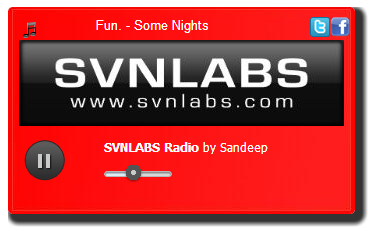고정 헤더 영역
상세 컨텐츠
본문
Shoutcast StreamingNew Line of FLASH PlayersWorks with Shoutcast AAC & AACplus / Shoutcast / IcecastOur NEW Micro BLACK Player -Click to play. Horizontal slide volume control. Artist / Title Information displayedMini Player -Click to play. Horizontal slide volume control. Real-time visualizer with 6 preset style (click to change). Station informationMicro Player -Click to playVU Meter Players- They come in 4 differentcolorsClick on a player for a demo.Spectrum Players- They come in 4 differentcolorsBelow is ourold original FLASH player.
You can change border colorQuestions & Answers:Q: How much does it cost?A: VU & Spectrum Players - $3 US permonth. Mini Player - $2 US per month. Micro Players - $1 USPer month (quarterly)Q: Are these the actual sizes of the players?A: Yes, the size is very close to actual.Q: I have 3 stations. Can I use the same playerfor each station?A: No, you need one player for each station.Q: I need to change my Station Name.
Do I need toput in a support ticket?A: No, the player(s) come with a control panel.You can set up the following:.IP Address.Port #.Mount Point (Icecast only).Station Name.Facebook URL.Twitter URL.Your e-mailQ: How can it possibly work for AAC / AACplus streams onShoutcast?A: We transcode the signal for you and the result is AACor AACplus on FLASH.Q: Am I limited to how many listeners I may have at anyone time?A: We fairly allow you to have 200 at any one time.Major station hogs that have thousands of listeners will be chargedextra for the bandwidth they use. For most stations, this is notan issue.Q: I want to buy the code to put on mywebsite. Do you sell it?A: No, we maintain the code on ourservers.
You just purchase a license to use the software.

The first four bits in the tag header indicate the compression format, and use 2 for MP3 and 10 for AAC. The sampling rate is indicated at the next two bits, which is a binary 00 indicating 5.5 kHz, a binary 01 indicating 11 kHz, a binary 10 indicating 22 kHz or a binary 11 indicating 44 kHz. Since AAC supports a wider range of sampling rates, you must always set AAC streams to 44 kHz. The last two bits indicate whether 8 or 16 bit-depth is used, which describes whether the sound being streamed is mono or stereo. When streaming AAC, there is an additional header byte, which indicates whether the data is an audio specification or compressed data. Audio specification is usually two bytes long and includes the file's compression method, sampling and channel information.
Icecast Web Player

The audio header is followed by the compressed data. The most popular format for Icecast by far is (MPEG-1 Layer III). The audio data is carried in frames and each frame contains a header and associated data. The header is four bytes long and includes a sync word, an MPEG version, layer information, sampling frequency, number of channel, and more. For more information, please see this description of the.
For MPEG-1 Layer III, each frame is composed of 1152 samples. If you use the 44.1 kHz sampling rate, one frame contains about 26 ms of audio data. The size of the compressed frame can be calculated based on the bitrate and sampling rate. After receiving data from the server, you must first find the MPEG header, so that the application can start decoding and playing the streaming audio right away. Since the sync word may appear in compressed data as well, I have used the following algorithm for synchronization: When the sync word is found, the potential header is checked for illegal values. Then, I calculate the frame length given the sampling rate and bitrate.

I use this value to skip the current frame and look for the sync word in the next frame. If the second sync word is found, then it is likely that the player has achieved synchronization and decoding begins. If synchronization becomes lost at any time, the above algorithm repeats to achieve re-synchronization. In addition to the MP3 format, Icecast supports AAC and Ogg Vorbis formats as well. AAC provides better sound quality than the older MP3 format. To deliver streaming audio, AAC data is most likely carried in either the Audio Data Interchange Format (ADIF) or via Audio Data Transport Stream (ADTS). You can parse these containers and create FLV audio tags in order to use the audio file with Data Generation Mode.
Flash Player does not natively supports audio. However, it is possible to play Ogg/Vorbis media using Data Generation Mode. You can use ActionScript to parse Ogg containers and decode Vorbis audio.
To learn more details, see this description of a. Create a new Flex Library Project and name it icecastPlayer. Replace the icecastPlayer/src folder located in the provided sample files. Notice that the icecastPlayer/bin/icecastPlayer.swc is generated automatically. Create a new ActionScript Project and name it icecastPlayerApp. In the properties of the icecastPlayerApp, select ActionScript Build Path pane. Click the Add SWC button and specify the icecastPlayer.swc generated in Step 3.
Add the following source code to icecastPlayerApp.as file. In this article, I described how to use the Data Generation Mode in Flash Player to play streaming audio with Icecast.
Data Generation Mode was introduced in Flash Player 10.1, so this strategy does require users to install Flash Player 10.1 or higher. Data Generation Mode is a very powerful and advanced API, enabling you to implement features that are not supported by Flash Player. You can also create streaming audio players for Flash Player that previously required additional server side components.




